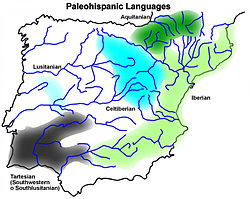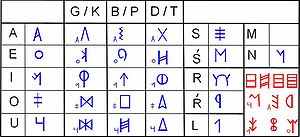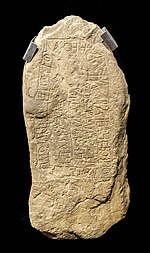| Tartessian | |
|---|---|
| Region | Southwest Iberian Peninsula |
| Extinct | after 5th century BC |
| Language family | unclassified
|
| Writing system | Southwest Paleo-Hispanic |
| Language codes | |
| ISO 639-3 | txr |
| Linguist List | txr |
| Glottolog | tart1237 |
 Approximate extension of the area under Tartessian influence Approximate extension of the area under Tartessian influence | |
| This article contains IPA phonetic symbols. Without proper rendering support, you may see question marks, boxes, or other symbols instead of Unicode characters. For an introductory guide on IPA symbols, see Help:IPA. | |

Tartessian is an extinct Paleo-Hispanic language found in the Southwestern inscriptions of the Iberian Peninsula, mainly located in the south of Portugal (Algarve and southern Alentejo), and the southwest of Spain (south of Extremadura and western Andalusia). There are 95 such inscriptions; the longest has 82 readable signs. Around one third of them were found in Early Iron Age necropolises or other Iron Age burial sites associated with rich complex burials. It is usual to date them to the 7th century BC and to consider the southwestern script to be the most ancient Paleo-Hispanic script, with characters most closely resembling specific Phoenician letter forms found in inscriptions dated to c. 825 BC. Five of the inscriptions occur on stelae that have been interpreted as Late Bronze Age carved warrior gear from the Urnfield culture.
Name
Most researchers use the term Tartessian to refer to the language as attested on the stelae written in the Southwestern script, but some researchers would prefer to reserve the term Tartessian for the language of the core Tartessian zone, which is attested for those researchers with some archaeological graffiti – like the Huelva graffito and maybe with some stelae such as Villamanrique de la Condesa (J.52.1). Such researchers consider that the language of the inscriptions found outside the core Tartessian zone would be either a different language or maybe a Tartessian dialect and so they would prefer to identify the language of the stelae with a different title: "southwestern" or "south-Lusitanian". There is general agreement that the core area of Tartessos is around Huelva, extending to the valley of the Guadalquivir, but the area under Tartessian influence is much wider (see maps). Three of the 95 stelae and some graffiti, belong to the core area: Alcalá del Río (Untermann J.53.1), Villamanrique de la Condesa (J.52.1) and Puente Genil (J.51.1). Four have also been found in the Middle Guadiana (in Extremadura), and the rest have been found in the south of Portugal (Algarve and Lower Alentejo), where the Greek and Roman sources locate the pre-Roman Cempsi and Sefes and Cynetes peoples.
History
The most confident dating is for the Tartessian inscription (J.57.1) in the necropolis at Medellín, Badajoz, Spain to 650/625 BC. Further confirmatory dates for the Medellín necropolis include painted ceramics of the 7th–6th centuries BC.
In addition, a graffito on a Phoenician shard dated to the early to mid 7th century BC and found at the Phoenician settlement of Doña Blanca near Cadiz has been identified as Tartessian by the shape of the signs. It is only two signs long, reading ]tetutute[. It does not show the syllable-vowel redundancy more characteristic of the southwestern script, but it is possible that this developed as indigenous scribes adapted the script from archaic Phoenician and other such exceptions occur (Correa and Zamora 2008).
The script used in the mint of Salacia (Alcácer do Sal, Portugal) from around 200 BC may be related to the Tartessian script, though it has no syllable-vowel redundancy; violations of this are known, but it is not clear if the language of this mint corresponds with the language of the stelae (de Hoz 2010).
The Turdetani of the Roman period are generally considered the heirs of the Tartessian culture. Strabo mentions that: "The Turdetanians are ranked as the wisest of the Iberians; and they make use of an alphabet, and possess records of their ancient history, poems, and laws written in verse that are six thousand years old, as they assert." It is not known when Tartessian ceased to be spoken, but Strabo (writing c. 7 BC) records that "The Turdetanians ... and particularly those that live about the Baetis, have completely changed over to the Roman mode of life; with most of the populace not even remembering their own language any more."
Writing

Tartessian inscriptions are in the Southwestern script, which is also known as the Tartessian or South Lusitanian script. Like all other Paleo-Hispanic scripts, except for the Greco-Iberian alphabet, Tartessian uses syllabic glyphs for plosive consonants and alphabetic letters for other consonants. Thus, it is a mixture of an alphabet and a syllabary that is called a semi-syllabary. Some researchers believe these scripts are descended solely from the Phoenician alphabet, but others think that the Greek alphabet had an influence as well.
The Tartessian script is very similar to the Southeastern Iberian script, both in the shapes of the signs and in their values. The main difference is that the Southeastern Iberian script does not redundantly mark the vocalic values of syllabic characters, which was discovered by Ulrich Schmoll and allows the classification of most of the characters into vowels, consonants and syllabic characters. As of the 1990s, the decipherment of the script was largely complete and so the sound values of most of the characters are known. Like most other Paleo-Hispanic scripts, Tartessian does not distinguish between voiced and unvoiced consonants ( from , from or from ).
Tartessian is written in scriptio continua, which complicates the identification of individual words.
Classification
Tartessian is generally left unclassified for lack of data or proposed to be a language isolate for lack of connections to the Indo-European languages. Some Tartessian names have been interpreted as Indo-European, more specifically as Celtic. However, the language as a whole remains inexplicable from the Celtic or Indo-European point of view; the structure of Tartessian syllables appears to be incompatible with Celtic or even Indo-European phonetics and more compatible with Iberian or Basque; some scholars consider that all Celtic elements are borrowings.
Since 2009, John T. Koch has argued that Tartessian is a Celtic language and that the texts can be translated.
Although some others, such as Terrence Kaufman, have accepted that Tartessian may be a Celtic language, this proposal has not been widely accepted by linguists. The current academic consensus regarding the classification of Tartessian as a Celtic language is summarized by de Hoz:
J. Koch’s recent proposal that the south-western inscriptions should be deciphered as Celtic has had considerable impact, above all in archaeological circles. However, the almost unanimous opinion of scholars in the field of Palaeohispanic studies is that, despite the author’s indisputable academic standing, this is a case of a false decipherment based on texts that have not been sufficiently refined, his acceptance of a wide range of unjustified variations, and on purely chance similarities that cannot be reduced to a system; these deficiencies give rise to translations lacking in parallels in the recorded epigraphic usage.
Texts



(The following are examples of Tartessian inscriptions. Untermann's numbering system (per MLH IV) or location name in newer transcriptions, is cited in brackets, e.g. (J.19.1) or (Mesas do Castelinho). Transliterations are by Rodríguez Ramos .)
Mesas do Castelinho (Almodôvar):
- tᶤilekᵘuṟkᵘuarkᵃastᵃaḇᵘutᵉebᵃantᶤilebᵒoiirerobᵃarenaŕḵᵉaφiuu
- lii*eianiitᵃa
- eanirakᵃaltᵉetᵃao
- bᵉesaruan
Segmentation: Tᶤile kᵘuṟkᵘuarkᵃas tᵃa ḇᵘutᵉebᵃan. Tᶤile bᵒoii tᵉero bᵃare naŕkᵉe aφiuuliieianii. Tᵃa eanira Kᵃaltᵉe. Tᵃa obᵉesaruan.
This is the longest Tartessian text known at present, with 82 signs, 80 of which have an identifiable phonetic value. The text is complete if it is assumed that the damaged portion contains a common, if poorly-understood, Tartessian phrase-form bᵃare naŕkᵉe. The formula contains two groups of Tartessian stems that appear to inflect as verbs: naŕkᵉe, naŕkᵉen, naŕkᵉeii, naŕkᵉenii, naŕkᵉentᶤi, naŕkᵉenai and bᵃare, bᵃaren, bᵃareii, bᵃarentᶤi from comparison with other inscriptions.
Fonte Velha (Bensafrim) (J.53.1):
- lokᵒobᵒoniirabᵒotᵒoaŕaiaikᵃaltᵉelokᵒonanenaŕekᵃaᶤiśiinkᵒolobᵒoiitᵉerobᵃarebᵉetᵉasiioonii
Segmentation: Logo bonii ra botoaŕaiai galte, logo nanenaŕeŋaginśiiugolo boii tero bare betasiioonii.
Herdade da Abobada (Almodôvar) (J.12.1):
- iŕualkᵘusielnaŕkᵉentᶤimubᵃatᵉerobᵃareᵃatᵃaneatᵉe
Segmentation: iŕual kᵘusiel naŕkᵉen tᶤimubᵃa tᵉero bᵃare-ᵃa. Tᵃa ne atᵉe.
In the texts above, there are repetition of bᵃare-, naŕkᵉe-, tᶤile-, bᵒoii-, -tᵉero-, kᵃaltᵉe-, lok-, -ᵒonii, whereas bᵒoii tᵉero-bᵃare repeats three times, with assumably rero as a corruption of tᵉero in Mesas do Castelinho transcription. tᶤile- and lokᵒo appear in the beginning of their sentences.
See also
- Arganthonios
- Celtiberian language
- Hispano-Celtic languages
- Iberian language
- Lusitanian language
- National Museum of Archaeology (Portugal)
- Paleohispanic languages
- Pre-Roman peoples of the Iberian Peninsula
References
- "Tartessian". Archived from the original on December 20, 2012. Retrieved 2024-01-31.
- Koch, John T. (2013). Celtic from the West 2 - Prologue: The Earliest Hallstatt Iron Age cannot equal Proto-Celtic. Oxford: Oxbow Books. pp. 10–11. ISBN 978-1-84217-529-3. Archived from the original on 2013-01-21. Retrieved 2014-03-14.
- Untermann (1997); Koch 2009-2012, Villar Liebana 2004–2012, Yocum 2012, &c.
- Correa (2009), p. 277; de Hoz 2007, p. 33; 2010, pp. 362–364.
- Untermann (1997), pp. 102–103; Mederos and Ruiz 2001.
- Correa 2009, p. 276.
- Catalogue numbers for inscriptions refer to Untermann (1997)
- Villar Liebana (2000), p. 423; Rodríguez Ramos 2009, p. 8; de Hoz 2010, p. 473.
- Correa 2009, p. 278.
- Villar Liebana (2000); de Hoz 2010.
- Rodríguez Ramos 2009
- Koch 2010 2011
- Almagro-Gorbea, M (2004). "Inscripciones y grafitos tartésicos de la necrópolis orientalizante de Medellín". Palaeohispanica: 4.13–44.
- Ruiz, M M (1989). "Las necrópolis tartésicas: prestigio, poder y jerarquas". Tartessos: Arqueología Protohistórica del Bajo Guadalquivir: 269.
- Strabo, Geography, book 3, chapter 1, section 6.
- Strabo, Geography, book 3, chapter 2, section 15.
- Untermann, Jürgen (1995). "Zum Stand der Deutung der "tartessischen" Inschriften". Hispano- Gallo-Brittonica: essays in honour of Professor D. Ellis Evans on the occasion of his sixty-fifth birthday. Cardiff: University of Wales Press. pp. 244–59.
- Untermann, Jürgen, ed. (1997). Monumenta Linguarum Hispanicarum; herausgegeben von Jürgen Untermann; unter Mitwirkungen von Dagmar Wodtko. Band IV, Die tartessischen, keltiberischen und lusitanischen Inschriften [Monumenta Linguarum Hispanicarum; edited by Jürgen Untermann; with the participation of Dagmar Wodtko. Volume IV, The Tartessian, Celtiberian and Lusitanian Inscriptions] (in German). Wiesbaden: Ludwig Reichert.
- "O'Donnell Lecture 2008 Appendix" (PDF).
- Rodríguez Ramos (2002)
- de Hoz (2010)
- Correa (1989); Untermann (1997)
- (Rodríguez Ramos 2002, de Hoz 2010)
- Koch, John T. (2009). Tartessian. Celtic in the South-West at the Dawn of History. Celtic Studies Publications, Aberystwyth. ISBN 978-1-891271-17-5.
- Koch, John T (2011). Tartessian 2: The Inscription of Mesas do Castelinho ro and the Verbal Complex. Preliminaries to Historical Phonology. Celtic Studies Publications, Aberystwyth. pp. 1–198. ISBN 978-1-907029-07-3.
- Villar Liebana, Francisco (2011). Lenguas, genes y culturas en la prehistoria de Europa y Asia suroccidental [Languages, genes and cultures in the prehistory of Europe and Southwest Asia] (in Spanish). Salamanca: Ediciones Universidad de Salamanca. p. 100. ISBN 978-84-7800-135-4.
- Koch, John T. "Common Ground and Progress on the Celtic of the South-western SW Inscriptions". Academia.edu. Retrieved 3 March 2017.
- Terrence Kaufman. 2015. Notes on the Decipherment of Tartessian as Celtic. Institute for the Study of Man Incorporated
- Sims-Williams, Patrick (2 April 2020). "An Alternative to 'Celtic from the East' and 'Celtic from the West'". Cambridge Archaeological Journal. 30 (3): 511–529. doi:10.1017/s0959774320000098. hdl:2160/317fdc72-f7ad-4a66-8335-db8f5d911437. ISSN 0959-7743. S2CID 216484936.
- Hoz, J. de (28 February 2019), "Method and methods", Palaeohispanic Languages and Epigraphies, Oxford University Press, pp. 1–24, doi:10.1093/oso/9780198790822.003.0001, ISBN 978-0-19-879082-2, retrieved 29 May 2021
- ^ Guerra 2009.
- ^ Untermann 1997.
Further reading
- Ballester, Xaverio (2004): «Hablas indoeuropeas y anindoeuropeas en la Hispania prerromana», Estudios de lenguas y epigrafía Antiguas – ELEA 6, pp. 107–138.
- Broderick, George (2010): «Das Handbuch der Eurolinguistik», Die vorrömischen Sprachen auf der iberischen Halbinsel, ISBN 3-447-05928-1, pp. 304–305
- Correa, José Antonio (1989). ""Posibles antropónimos en las inscripciones en escritura del S.O. (o Tartesia)"" [«Possible anthroponyms in the inscriptions in writing of the S.O. (or Tartessia)»]. Veleia (in Spanish). 6: 243–252.
- Correa, José Antonio (1992): «La epigrafía tartesia», Andalusien zwischen Vorgeshichte und Mittelalter, eds. D. Hertel & J. Untermann, pp. 75–114.
- Correa, José Antonio (1995): «Reflexiones sobre la epigrafía paleohispánica del suroeste de la Península Ibérica», Tartessos 25 años después, pp. 609–618.
- Correa, José Antonio (2009). "«Identidad, cultura y territorio en la Andalucía prerromana a través de la lengua y la epigrafía»". In Alonso, F. Wulff; Martí-Aguilar, M. Álvarez (eds.). Identidades, culturas y territorios en la Andalucía prerromana. Málaga. pp. 273–295.
- Correa, José Antonio, Zamora, José Ángel (2008): «Un graffito tartessio hallado en el yacimiento del Castillo do Dona Blanca», Palaeohispanica 8, pp. 179–196.
- Correia, Virgílio-Hipólito (1996): «A escrita pré-romana do Sudoeste peninsular», De Ulisses a Viriato: o primeiro milenio a.c., pp. 88–94.
- Eska, Joseph (2013): Review: "John T. Koch, Barry W. Cunliffe (ed.), Celtic from the West 2: Rethinking the Bronze Age and the Arrival of Indo-European in Atlantic Europe. Celtic studies publications, 16. Oxford; Oakville, CT: Oxbow Books, 2013". Bryn Mawr Classical Review 2013.12.35.
- Eska, Joseph (2014): «Comments on John T. Koch’s Tartessian-as-Celtic Enterprise», Journal of Indo-European Studies 42/3-4, pp. 428–438.
- Gorrochategui, Joaquín (2013): “Hispania Indoeuropea y no Indoeuropea”, in Iberia e Sardegna: Legami linguistici, archeologici e genetici dal Mesolitico all’Età del Bronzo - Proceedings of the International Congress «Gorosti U5b3» (Cagliari-Alghero, June 12–16, 2012), pp. 47–64.
- Guerra, Amilcar (2002): «Novos monumentos epigrafados com escrita do Sudoeste da vertente setentrional da Serra do Caldeirão», Revista Portuguesa de arqueologia 5-2, pp. 219–231.
- Guerra, Amilcar (2009). "Novidades no âmbito da epigrafia pré-romana do sudoeste hispânico" [Novelties within the pre-Roman epigraphy of the Hispanic southwest] (PDF). Acta Palaeohispanica X, Palaeohispanica (in Portuguese). 9: 323–338.
- Guerra, Amilcar (2013): “Algumas questões sobre as escritas pré-romanas do Sudoeste Hispánico”, in Acta Palaeohispanica XI: Actas del XI coloquio internacional de lenguas y culturas prerromanas de la Península Ibérica (Valencia, 24-27 de octubre de 2012) (Palaeohispanica 13), pp. 323–345.
- Hoz, Javier de (1995): «Tartesio, fenicio y céltico, 25 años después», Tartessos 25 años después, pp. 591–607.
- Hoz, Javier de (2007): «Cerámica y epigrafía paleohispánica de fecha prerromana», Archivo Español de Arqueología 80, pp. 29–42.
- Hoz, Javier de (2010): Historia lingüística de la Península Ibérica en la antigüedad: I. Preliminares y mundo meridional prerromano, Madrid, CSIC, coll. « Manuales y anejos de Emerita » (ISBN 978-84-00-09260-3, ISBN 978-84-00-09276-4).
- Koch, John T. (2010): «Celtic from the West Chapter 9: Paradigm Shift? Interpreting Tartessian as Celtic», Oxbow Books, Oxford, ISBN 978-1-84217-410-4 pp. 187–295.
- Koch, John T. (2011): «Tartessian 2: The Inscription of Mesas do Castelinho ro and the Verbal Complex. Preliminaries to Historical Phonology», Oxbow Books, Oxford, ISBN 978-1-907029-07-3 pp. 1–198.
- Koch, John T. (2011): «The South-Western (SW) Inscriptions and the Tartessos of Archaeology of History», Tarteso, El emporio del Metal, Huelva.
- Koch, John T. (2013): «Celtic from the West 2 Chapter 4: Out of the Flow and Ebb of the European Bronze Age: Heroes, Tartessos, and Celtic» Archived 2013-01-21 at the Wayback Machine, Oxbow Books, Oxford, ISBN 978-1-84217-529-3 pp. 101–146.
- Koch, John T. (2014a): «On the Debate over the Classification of the Language of the South-Western (SW) Inscriptions, also known as Tartessian», Journal of Indo-European Studies 42/3-4, pp. 335–427.
- Koch, John T. (2014b): «A Decipherment Interrupted: Proceeding from Valério, Eska, and Prósper», Journal of Indo-European Studies 42/3-4, pp. 487–524.
- Mederos, Alfredo; Ruiz, Luis (2001): «Los inicios de la escritura en la Península ibérica. Grafitos en cerámicas del bronce final III y fenicias», Complutum 12, pp. 97–112.
- Mikhailova, T. A. (2010) Review: "J.T. Koch. Tartessian: Celtic in the South-West at the Dawn of history (Celtic Studies Publication XIII). Aberystwyth: Centre for advanced Welsh and Celtic studies, 2009" Вопросы языкознания 2010 №3; 140-155.
- Prósper, Blanca M. (2014): "Some Observations on the Classification of Tartessian as a Celtic Language". Journal of Indo-European Studies 42/3-4, pp. 468–486.
- Rodríguez Ramos, Jesús (2000): “La lectura de las inscripciones sudlusitano-tartesias”. Faventia 22/1, pp 21–48.
- Rodríguez Ramos, Jesús (2002a): “El origen de la escritura sudlusitano-tartesia y la formación de alfabetos a partir de alefatos”. Rivista di Studi Fenici 30/2, pp. 187–216.
- Rodríguez Ramos, Jesús (2002b): "Las inscripciones sudlusitano-tartesias: su función, lingua y contexto socioeconómico". Complutum 13, pp. 85–95.
- Rodríguez Ramos, Jesús (2009): «La lengua sudlusitana», Studia Indogermanica Lodziensia VI, pp. 83–98.
- Valério, Miguel (2008 ): “Origin and Development of the Paleohispanic scripts: The Orthography and Phonology of the Southwestern Alphabet". Revista Portuguesa de Arqueologia 11-2, pp. 107–138.
- Valério, Miguel (2014): "The Interpretative Limits of the Southwestern Script". Journal of Indo-European Studies 42/3-4, pp. 439–467.
- Untermann, Jürgen (2000). "Lenguas y escrituras en torno a Tartessos" [Languages and scripts around Tartessos]. Argantonio: Rey de Tartessos [Argantonio: King of Tartessos] (in Spanish). Madrid. pp. 69–77.
{{cite book}}: CS1 maint: location missing publisher (link) - Villar Liebana, Francisco (2000). Indoeuropeos y no indoeuropeos en la Hispania prerromana [Indo-Europeans and non-Indo-Europeans in pre-Roman Hispania] (in Spanish). Ediciones Universidad de Salamanca. ISBN 978-84-78-00968-8.
- Villar Liebana, Francisco (2004). "The Celtic Language of the Iberian Peninsula". Studies in Baltic and Indo-European Linguistics in Honor of William R. Schmalstieg. Current Issues in Linguistic Theory. 254: 243–274. doi:10.1075/cilt.254.30vil. ISBN 978-90-272-4768-1.
- Wikander, Stig (1966): «Sur la langue des inscriptions Sud-Hispaniques», in Studia Linguistica 20, 1966, pp. 1–8.
- Wodtko, Dagmar (2021). "De Ortografía Tartésica". In: Palaeohispanica. Revista Sobre Lenguas Y Culturas De La Hispania Antigua 21 (diciembre), pp. 219–234. https://doi.org/10.36707/palaeohispanica.v21i0.411.
External links
[REDACTED] Media related to Tartessian language at Wikimedia Commons
| Language families of Eurasia | |||||||
|---|---|---|---|---|---|---|---|
| Europe | |||||||
| West Asia | |||||||
| Caucasus | |||||||
| South Asia | |||||||
| East Asia | |||||||
| Indian Ocean rim | |||||||
| North Asia |
| ||||||
| Proposed groupings |
| ||||||
| Substrata | |||||||
| |||||||